We awoke to the sound of birds. After warming up with a small fire, we packed and headed out. On the way, we stopped at the Erickson Cemetery at the monument entrance.


The Erickson family on a picnic in the late 1800's. (left to right) Helen Hildegard, Emma, Neil and Lewis Benton (Ben). Not pictured is Lillian, the oldest, who is buried at the Riggs family cemetery a few miles west of here.

Emma Sophia Peterson (1854 - 1950) and Neil Erickson (1859 - 1937)
Emma was born in Sweden. When her mother died giving birth to her seventh child, Emma's father married the family housekeeper. Emma didn't get along well with her new stepmother and left home when she was a teenager. She had a brother and sister already living in the USA, so she went to stay with them. She was working at Fort Bowie when she met Neil, whom she married in 1887. Their first child, Lillian, was born there.
Neil (or Nels) was the first child of a poor farm family. When he was 10, his father left to the US. Two years later, he was killed by Indians while working for the railroad. As the oldest child, much of the responsibility for the support of the family fell to him. After spending his teen years working, he left Sweden in 1879 as a stowaway. He worked for an uncle living in Massachusetts, then changed jobs several times until he signed up for the military... fighting Indians, in memory of his father. Within a few months, he was stationed in southwestern New Mexico Territory, in the midst of the Apache wars.

Hildegard Hutchison (1895 - 1978), their youngest child, born at Faraway Ranch

Aw, how sweet. Jess Stanley is Hildegard's son. She married Jess W. Hutchinson in 1920.
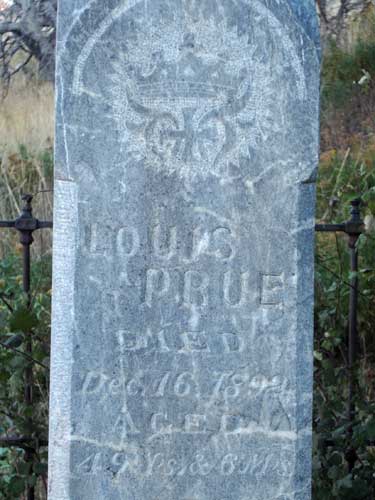
The Ericksons' nearest neighbor was Louis Prue. He had served as a scout under General George Crook. He moved into this area in 1879 and established a cattle ranch here in the valley nine years before the Ericksons arrived. He was thrown from his horse and killed in 1892. His burial established this cemetery. It was his wish to be buried at the mouth of the canyon under a tree, where he could see his cattle passing on the way to water.
We continued on to Tombstone.

Skimming near the border of Mexico
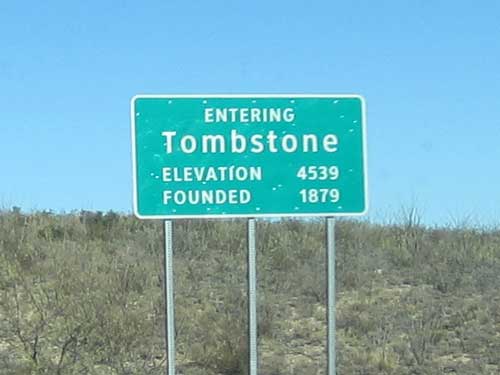
Our first stop was Boothill... the historic cemetery. There are many "boothills" in the wild west. The original one is in Dodge City, Kansas, but this is perhaps the most famous one. The term implies that they died violently (gunfights or hanging) and not natural causes... basically they 'died with their boots on.'

Ok, it looks just sliiiightly touristy. There was at least no fee to get in but one could buy a handly little brochure describing the graves for a few bucks.
Boothill Graveyard (originally called the Tombstone Cemetery) was used from 1878 to 1884, officially closing in late 1886 when the new city cemetery was opened. By the 1920's, the 'old city cemetery' had fallen into ruin... although it was used a couple times later to bury a few outlaws (some legally hanged; one shot in a robbery) as well as a Emmett Crook Nunnally, a volunteer caretaker. It was eventually restored based on early burial records.
The graveyard is believed to hold over 300 persons, only 205 of which are recorded. This was due to some people (especially Chinese and Jewish immigrants) being buried without any record. Most of the loss, however, was due to neglect and theft of wooden grave markers as souvenirs.


The most famous graves are those of the men involved in the gunfight at the O.K. Corral.
THE LAWMEN
Town Marshal Virgil Walter Earp (wounded)
Assistant Town Marshal Morgan Seth Earp (wounded)
Temporary Deputy Marshal Wyatt Berry Stapp Earp (unharmed)
Temporary Deputy Marshal John Henry ‘Doc’ Holliday (wounded)

Virgil Earp, Morgan Earp, Wyatt Earp, Doc Holliday
THE COWBOYS
Thomas 'Tom' McLaury (killed)
Robert Findley 'Frank' McLaury (killed)
Joseph Issac 'Ike' Clanton (escaped)
William Harrison 'Billy' Clanton (killed)
William Floyd 'Billy' Claiborne (escaped)

Those killed: Tom McLaury, Frank McLaury, Billy Clanton

Those who survived: Ike Clanton, Billy Claiborne
Many of the facts leading up to the gunfight and details of the gunfight itself are uncertain. Newspapers of the day tended to take sides. According to the lawmen, the fight was in self-defense because the cowboys aggressively threatened them and refused to hand over their weapons. The cowboys insisted that they raised their hands, offering no resistance, and were shot in cold blood. Like most stories that reach this magnitude, it had a long history of personal conflicts and feuds. Each side had strong family ties.
James, Virgil (as deputy marshall) and Wyatt Earp arrived in Tombstone with their wives in 1879, during a period of rapid growth associated with mining when there were only a few hundred residents. Morgan and Warren Earp arrived the following year. They invested in mining claims and water rights. They had never worked as cowmen or ranchers.
Through the summer of 1881, bands of rustlers roamed the backcountry, stealing cattle (mostly from Mexican ranchers) then reselling them to other 'legitimate' ranchers for resale. The Clanton and McLaury family ranches were reputed to be the headquarters for the stolen cattle. The Mexican government lodged protests with federal and territorial officials to try to stop these crimes against Mexican citizens. It was suggested that a state militia be put together to stop the rustling, but this was voted down. So Mexico built a series of forts along the border and began to fight back against the outlaws, even killing men on US land. Rustling, robberies and other crimes continued to escalate... and there was little to stop it.
Cochise County Sheriff John Behan was charged with combating the rustlers, and together with his band of men (including the Clantons and McLaurys) became known as the Cowboys. But he was little better than the men he was ordered to run down. The Earps then began taking an aggressive stand against the region’s criminal elements.... and the Cowboys resented this. Ike Clanton decided to make a deal to turn on his Cowboy comrades, but he had suspicions of his own betrayal from the Earps. Tensions rose and lives were threatened.
On October 26, 1881, things finally boiled over. Ike, drunk and angry, began calling for a shootout with the Earps. The Earps violently apprehended him and charged him a fine for carrying a firearm within city limits. Tom McLaury arrived and confronted Wyatt Earp, who beat him up using his gun. Frank McLaury and Billy Clanton heard of the news about their brothers from Billy Claiborne. They all gathered at the O.K. Corral to make plans. Meanwhile, the Earps gathered in front of Hafford’s Corner Saloon. They asked Sheriff Behan to assist them in disarming the Cowboys. Behan instead offered to go talk to them to see if he could peaceably disarm them by himself.
They gave up waiting for Behan's return and began to walk down to confront the Cowboys themselves. En route, they encountered Behan who told them to stop or there would be trouble. But they continued on. The shooting began quickly... about 30 shots were fired in 30 seconds, with some men only 6 feet across from each other. Ike ran off as did Billy Claiborne. (Ike was killed fleeing authorities for charges of cattle rustling 6 years later; Billy was killed the following year in a drunken altercation).
Initially it was believed that the lawmen had been in the right. But as the inquiries began, Sheriff Behan and his Cowboy friends reported that the Earp party had fired first. In the Earp version, it was self-defense (that they didn't even have their guns out when they approached); by the Cowboys' account, it was murder (and that some of the Cowboys were even unarmed). After the preliminary hearing, the judge ruled the case not be bound over for trial, that there was not enough evidence to assure a likelihood of conviction. Speculation as to the true events still abound. Each side had its own motivation for telling it as they did, as did many of the witnesses.
The gunfight was not the end of the conflict, however. Two months later, Virgil Earp was ambushed and injured in a murder attempt by the Cowboys. In March of the following year, Cowboys shot and killed Morgan Earp. The suspects in both incidents had alibis... supplied by fellow Cowboys. Wyatt Earp became Deputy Marshal in Cochise County and continued the personal vendetta. Eventually he was pursued by Sheriff Behan.

Murdered in the streets of Tombstone

'Old Man' Clanton was a cattle rancher and the father of Ike and Billy Clanton. He too was reportedly involved with stealing cattle from Mexican ranchers and re-selling them. It is believed he participated in the Skeleton Canyon Massacre of Mexican smugglers. In retaliation, Mexican military forces patrolling the border supposedly ambushed and killed him and a crew of Cowboys in the Guadalupe Canyon Massacre.

Newman Haynes Clanton (c. 1816 - 1881)
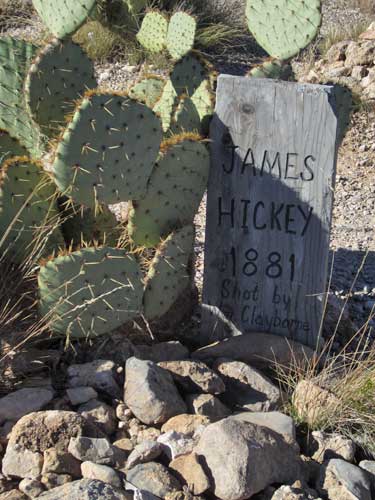
James Hickey, 1881, Shot by Wm. Clayborne. Hickey was drunk felt the 21-year-old Claiborne (shortly before his O.K. Corral fame) would be an easy target. He began following and provoking him. After a confrontation, Claiborne shot him in the face, killing him instantly. Hickey was not well-liked so it was ruled self-defense.
Ironically, Claiborne himself was shot and killed the following year while drunk. The bartender, Frank Leslie, asked him to leave because of his belligerent behavior and accusations of killing Johnny Ringo (another of the Cowboys). Claiborne refused so Leslie physically threw him out. It turned into a confrontation outside. Claiborne fired and missed. Leslie shot back, mortally wounding him.

Killeen, 1880, Shot by Frank Leslie. Another of Leslie's victims. This was as the result of a disagreement over Killeen's wife... whom Leslie then married.
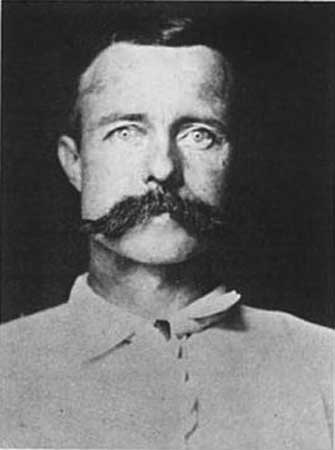
Nashville Franklyn "Buckskin Frank" Leslie (1842 - after 1920) was an army scout, gambler, bartender, rancher, miner, gunfighter and con-man (probably exaggerating most of the wild stories of his life). He was nicknamed for his fringed buckskin jacket. Apparently he killed both Hickey and Killeen in self-defense. He married Killeen's widow eight days later. Following their divorce, Leslie later shot and killed a woman he lived with at his ranch while drunk and in a fit of jealousy. He was sentenced to life in prison but only served six years before he was pardoned. He was last listed in a 1920 census in California, but no public records of him have been found after this date and it's not known when he died.
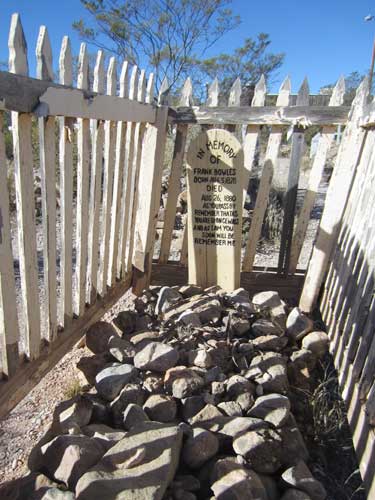
"In memory of Frank Bowles, born Aug. 5, 1828, died Aug. 26, 1880. As you pass by, remember that as you are, so once was I, and as I am, you soon will be. Remember me." According to his daughter, Frank's horse became frightened and threw him off. This caused a rifle to discharge and badly injure his knee. He lay in camp for several weeks without medical attention and when friends took him to a doctor for amputation it was too late.
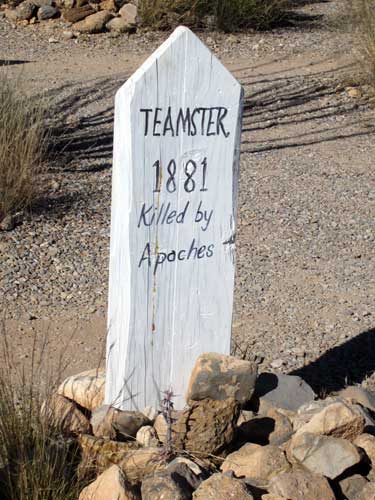

Ernest Brodines, 1882, murdered. Originally from Germany, Brodines was a miner found dead in his cabin with four bullet wounds in his body. Suspected of the killing was his partner, with whom he had been quarreling and who had now disappeared.
In the background are May Doody, 1881, died of diphtheria, and Thos. (short for Thomas) Cowan, an 11-month-old child who died of the same thing in the same year. Before the introduction of antibiotics and immunizations, which started in the 1920s, diphtheria epidemics could decimate populations... primarily targeting children. Diphtheria is a bacterial infection that usually affects the nose and throat. It would create a thick grey mucus that could block the airway, causing one to struggle for breath. In advanced stages, it could damage the heart, kidneys, liver and nervous system. This could lead to heart failure, paralysis and death.

Mead, 1881, sudden death. Mead was a blacksmith for Sandy Bob's stables and was found dead early one morning in the rear seat of one of the coaches.

Here lies George Johnson, hanged by mistake, 1882, He was right, we was wrong, but we strung him up and now he's gone. Johnson had innocently bought a stolen horse and suffered the consequences.
In the background is Joseph Ziegler, murdered, 1882. Ziegler, age 27, was shot one night in the chest by Ed Williams and lived only a few minutes. He and Ed were miners who had been quarreling at work that day. The murder took place behind an old ice house.

Dick Toby, shot by Sheriff Behan
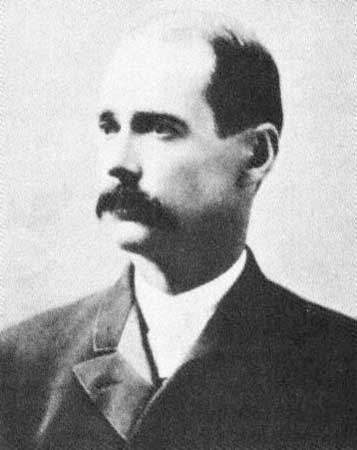
John Harris Behan (1844 - 1912) was the sheriff during the gunfight at the O.K. Corral. One of his duties was collecting prostitution, gambling, liquor and theater fees/taxes... of which he received 10%. He developed a reputation for political corruption and dishonesty. In 1866, he fell for 14-year-old Victoria and married her three years later. Only three months after they were married, a daughter, Henrietta, was born. Later they had a son. In 1875, Victoria filed for divorce, accusing Behan of consorting with prostitutes and of domestic abuse. Behan didn't contest any of her allegations and was ordered to pay $16.16 a month in child support for his son. He refused to pay anything for his daughter, saying she wasn't his. Henrietta died two years later at the age of 7 of scarlet fever. Behan didn't restrict his affairs to paid engagements. Throughout his life, he had relationships with numerous women, including the wives of friends and business partners. Even his mistress once found him in bed with another woman.

John Heath, taken from county jail and lynched by Bisbee mob, Feb. 22, 1884
John T. Heath's life consisted of cattle rustling, robbery, burglary, running a house of prostitution, a saloon and a dance hall. It was common knowledge that the town of Bisbee, Arizona, didn't have a bank and that the cash payroll for the Copper Queen Mine was delivered to the mercantile store a day or two in advance of the company's payday. Heath arranged for five accomplishes to rob it. On one December evening in 1883, they rode into town. Three of them entered the store while the other two remained outside. They forced the store owner to open the safe... only to find that the payroll had not yet arrived! They took what cash there was and well as robbed the employees and customers in the store. Meanwhile, passing citizens recognized that a robbery was in progress. The robbers killed one man with a shot to the head. When the Deputy Sheriff ran out to see what was happening, they killed him too. A local man was wounded in the leg as he was trying to escape the shooting. Both a pregnant woman (the bullet shattered her spine) and a man standing next to his wagon (shot in the chest) died later that evening. The robbers escaped, divided the money and went their separate ways. Eventually they were all captured.
John Heath requested to be tried separately for the 'Bisbee massacre.' Since there were no witnesses placing him at the crime, he was only convicted of second-degree murder and sentenced to life in prison. The public was unhappy with this verdict and a large lynch mob broke into the county jail at the Tombstone Courthouse, disarmed the guards, and took Heath to a nearby telegraphs pole where they lynched him.
The other five men had been convicted and were sentenced to hang a month later. They were to be the first criminals to be legally hanged in Tombstone. It turned into an exhibition, with the sheriff sending out invitations, and a local businessman building a grandstand and selling tickets starting at $1.50 per seat! A special gallows was built which could accommodate all five men at once. More than 1,000 people witnessed the hangings. To their last breath, the men protested their innocence. They are buried here as well under one gravestone. While the grave marker for Heath stands here, his body was returned to his family in Texas where he lies in an unmarked grave.

The lynching of John Heath

Delia William, 1881, suicide. The fire of 1881 caused significant property damage in tombstone. Most folks managed to recover, but for Delia Williams, the 'colored' proprietress of a new boarding house, the loss was catastrophic. Along with her building, she lost $1,700 in cash which she had hidden on the premises. Eleven week later, she publicly announced the sale of all of her personal effects for the sum of $123. That same day, she took a dose of arsenic and died two days later. Other suicides in the cemetery included John King by strychnine and Mrs. Pring with a large dose of hydrate chloral (a sedative).

Mrs. Ah Lum (China Mary), born in China, died in Tombstone, Dec 6, 1906, aged 67 years. China Mary was married to Ah Lum, a co-owner of the Can-Can Restaurant. She had great power over Hoptown (what the white people called the Chinese section of town), which consisted of 300 to 500 Chinese residents. She controlled Chinese prostitution and all opium trade; managed all Chinese laborers (as well as received their paychecks); had shares in most of the Chinese businesses such as laundries and restaurants; ran a gambling hall; loaned money; etc. In spite of all her shady operations, that she was Chinese, AND that she was a woman, Mary was well respected and liked in Tombstone. She took care of the sick, injured or hungry and no one was ever turned from her door. She died of heart failure and was buried here with a giant funeral. However, instead of abiding by the tradition of having her body exhumed after one year and the bones shipped back to China for permanent burial, she chose to remain here.

China Mary... also Mary Sing or Mary Ah Chum

John Swain Slaughter, Born June 1845, former slave who came to tomstone 1879, died Feb. 8, 1945 - erected by the personnel at Fort Huachuca and friends of Tombstone in memory of a worthy pioneer. John was born a slave. His mother was hired as domestic help by John Horton 'Texas John' Slaughter. They arrived in Tombstone in 1879. Swain was an expert tracker, an excellent shot, a miner, a bronco rider, fought one round with heavyweight boxing champion John Sullivan in 1884, and helped John build his cattle empires in New Mexico and Texas. He died a few months shy of his 100th birthday.

Perched atop his gravestone was a Great Roadrunner, a member of the cuckoo family. Although capable of limited flight, it spends most of its time on the ground. It can run at speeds of up to 20 mph. And while it can use this to outmaneuver enemies, coyotes are faster (with speeds up to 45 mph)!

Red River Tom, Shot by Ormsby. Also in this cemetery are gravestones saying "Bronco Charley, shot by Ormsby" and "Ormsby, shot." But any further information as to who these people were remains elusive. All three names, however, suspiciously appear in a fictional short story called Texas Thompson's Election, written by Alfred Henry Lewis (1855 - 1914) as part of a collection called Wolfville: Episodes of Cowboy Life (1893).

Dutch Annie, 1883. Dutch Annie was a prostitute and madam during the early 1880’s. She was called the Queen of the Red Light District, and like most women of her profession, her real name is unknown.... although there was a license issued to a "Dutch Annie" Smith in 1881 to run a House of Ill Fame (the Bird Cage Theater aka nightclub/brothel, which closed in 1889 and reopened in 1934 as a historic landmark/museum). Dutch Annie was known for her generosity and gave money to those in need during difficult financial times. When she died, her funeral was attended by more than 1,000 people, including not only the girls from the Red Light District, but also the town's dignitaries, businessmen and other citizens.

Dutch Annie
Unfortunately we didn't have time to see all of the 200+ markers, but here are a few more interesting stories of those buried here:
- Unknown man found at the bottom of a 60-foot shaft of the abandoned Minute Mine. He was well-dressed, indicating he was not a miner. No identification of any kind. 1882
- Van Houten was beaten in the face with a stone until he died. There was trouble was over his mining claim, which he had not recorded. 1879
- Tom Waters was shot after good natured comments about his new black and blue plaid shirt turned into a brawl (of course, too much liquor was involved). 1880
- Florentino "Indian Charlie" Cruz was found dead with several bullet wounds in his body. He was the first man to be killed during the Earp Vendetta Ride in retaliation for killing Morgan Earp. 1882
- Chas. Helm was shot by Wm. McCauley when the two ranchers disagreed over the best way to drive cattle, fast or slow. 1882
- Jos. Wetsell was stoned to death by Apaches. His friends were nearby and it was thought the Indians
wanted to avoid attracting their attention by shooting him. 1882
- Margarita (a prostitute) was stabbed in the neck by another prostitute, Little Gertie "Gold Dollar" when Margarita succeeded in stealing away a cowboy named Billy Milgreen.
- J. D. McDermott was killed when his horse fell with him while crossing the San Pedro River. His spinal column was fractured. 1882
- John Martin was killed while working on the Huachuca water line. A tested pipe was unplugged and a blast of water hurled a jack against his chest. 1882
- Hilly Hickson, a school boy, fell while walking on a pair of stilts and injured his back. He seemed only slightly injured, but next morning he died suddenly with a spasm. 1882
- Mrs. R. B. Campbell died very suddenly of severe stomach cramps and spasms. Suspected poisoning. 1882
- Mrs. Stump died from an overdose of chloroform during childbirth, given her by the doctor. 1884
- Seymour Dye and Harry Curry were bringing in a load of hay when they were shot by Indians, who then dragged them for 150 feet. 1882
- Lester Moore was a Wells Fargo agent who had a dispute with a man over a package. Both died.
- M. Lopez died in closed room from charcoal fumes. 1880
- 3-Fingered Jack Dunlop was part of a group of train robbers. During an attempt to rob an express car, he was shot by lawman Jeff Milton, who was on guard. Although seriously wounded, he managed to escape. The outlaws split up, but Dunlop fell from his horse only a few miles from the robbery. He lay there for fourteen hours before a posse found him. He was taken to Tombstone, where he died about 10 days later. 1900
- George Whitcer was a miner who was killed when a cable broke, hurling the cage to the bottom of the shaft. 1882
- John Wickstrum was killed when a well he was digging caved in. 1882
- Guadalupe Robles gave shelter to some robbers (one of whom was his brother) and was shot when the officers came to arrest them.
- Johnnie Wilson was shot by King after the two gunmen had a discussion of the fastest way to draw.
- Johnnie Blair died of smallpox. A rope was thrown over his feet and and he was dragged to the grave.
- Agnes Kenney was a one-year-old baby who was given calomel (a strong laxative) by the doctor. After eating an orange, she 'became salivated' and died. 1878
And the list continues... shot, hanged, stabbed, drowned, saloon brawl, murdered, blown up in a blast, burned to death, argument over a cock fight, struck on the back of a head with a poker, killed by Indians, killed by a jealous woman, trampled by horses, killed in a stampede, fell from a wagon and skull was crushed by a wheel, drinking stagnant or poison mine water, fell head first from a cliff, heart trouble, overwork, natural death, child birth, died in surgery, inflammation of the bowels, meningitis, nephritis, pneumonia, scarlet fever, "rapid consumption", leprosy and food poisoning.
We then headed to the historic downtown.
Tombstone was founded by Ed Schieffelin, an army scout who often searched the wilderness looking for valuable ore. But in such a hostile environment, he was told by friends The only rock you will find out there will be your own tombstone." Eventually in 1877, he found pieces of silver ore which led him to a giant silver vein... which he claimed and named Tombstone. A small settlement of tents and wooden shacks was built, with a population of about 100. Eventually a town was started nearby that had more space. By 1879, a few thousand folks had moved in, hoping to strike it rich.

Ed Schieffelin, 1880
The town prospered until 1890. Its population grew to 14,000 in less than seven years. It had a bowling alley, four churches, an ice house, a school, an opera house, two banks, three newspapers, an ice cream parlor, 110 saloons, 14 gambling halls, and numerous dancing halls and brothels.

Tombstone, 1881
Due to poor building practices common to boomtown construction, Tombstone was hit by two major fires. The first in 1881 destroyed most of the eastern half of the business district. It began when a lit cigar ignited a barrel of whiskey in a saloon. The next, more destructive, fire hit in 1882. It began in a Chinese laundry and destroyed over100 businesses and most of the business district. Lacking enough water to extinguish the flames, buildings in the fire's path were dynamited to create a fire break.

After the 1882 fire, all that was left standing of the O.K. Corral was its sign.
In the mid-1880's, the silver mines hit the water table. At first, the flow wasn't large enough to stop work, but soon it did. Even constant pumping was barley sufficient and the silver ore deposits were soon underwater. Mining companies made significant investments in specialized pumps, but in 1886, a fire destroyed the pumping plant and it was unprofitable to rebuild it. The city essentially became a ghost town, but today it has been saved by tourism.
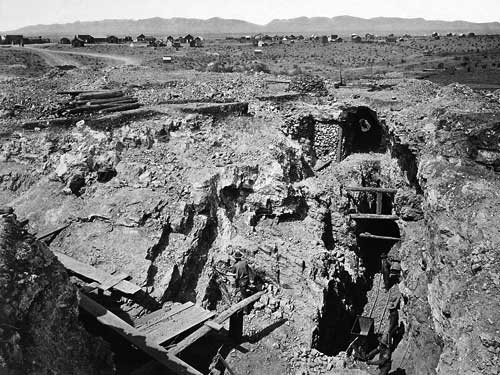
The Tough Nut Mine

